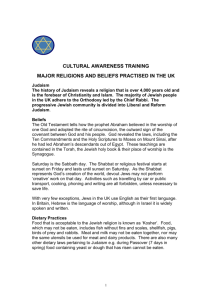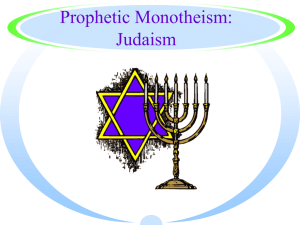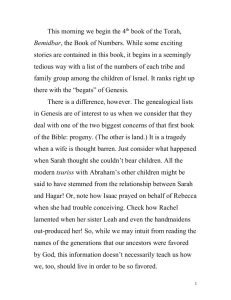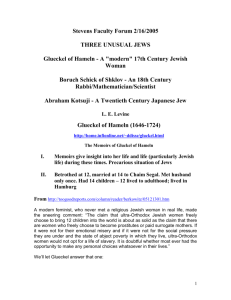98. Holy Places in Judaism
advertisement
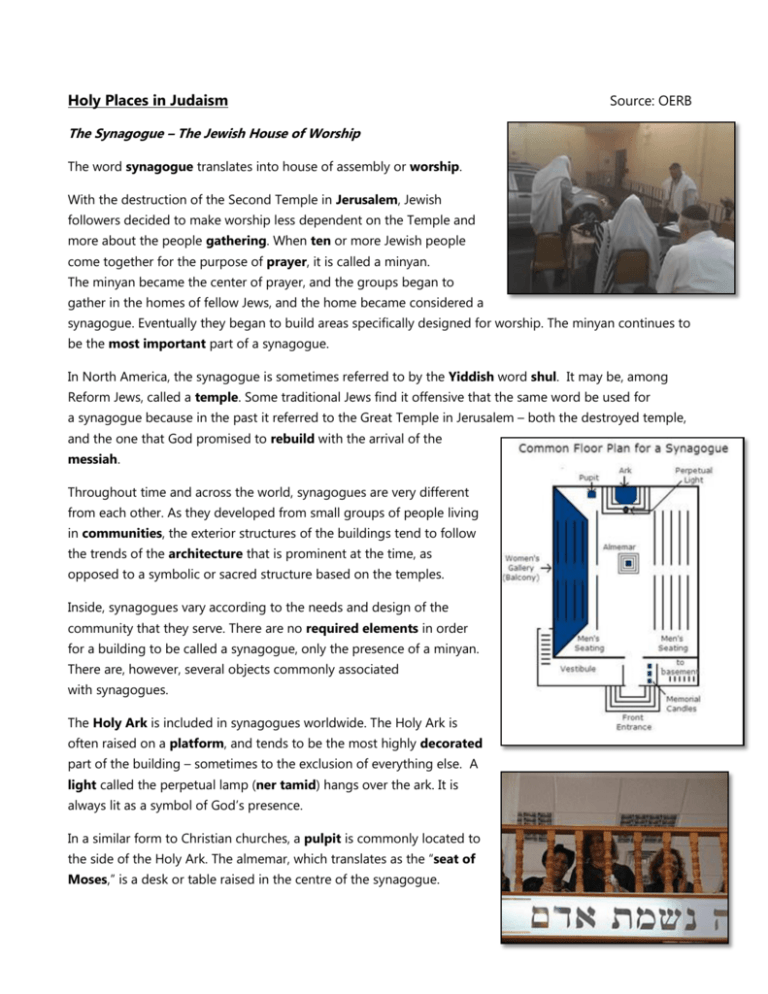
Holy Places in Judaism Source: OERB The Synagogue – The Jewish House of Worship The word synagogue translates into house of assembly or worship. With the destruction of the Second Temple in Jerusalem, Jewish followers decided to make worship less dependent on the Temple and more about the people gathering. When ten or more Jewish people come together for the purpose of prayer, it is called a minyan. The minyan became the center of prayer, and the groups began to gather in the homes of fellow Jews, and the home became considered a synagogue. Eventually they began to build areas specifically designed for worship. The minyan continues to be the most important part of a synagogue. In North America, the synagogue is sometimes referred to by the Yiddish word shul. It may be, among Reform Jews, called a temple. Some traditional Jews find it offensive that the same word be used for a synagogue because in the past it referred to the Great Temple in Jerusalem – both the destroyed temple, and the one that God promised to rebuild with the arrival of the messiah. Throughout time and across the world, synagogues are very different from each other. As they developed from small groups of people living in communities, the exterior structures of the buildings tend to follow the trends of the architecture that is prominent at the time, as opposed to a symbolic or sacred structure based on the temples. Inside, synagogues vary according to the needs and design of the community that they serve. There are no required elements in order for a building to be called a synagogue, only the presence of a minyan. There are, however, several objects commonly associated with synagogues. The Holy Ark is included in synagogues worldwide. The Holy Ark is often raised on a platform, and tends to be the most highly decorated part of the building – sometimes to the exclusion of everything else. A light called the perpetual lamp (ner tamid) hangs over the ark. It is always lit as a symbol of God’s presence. In a similar form to Christian churches, a pulpit is commonly located to the side of the Holy Ark. The almemar, which translates as the “seat of Moses,” is a desk or table raised in the centre of the synagogue. The Torah is read here, and there may be a podium to hold the Torah. The almemar is also used for teaching. Men and women are not permitted to pray together in Orthodox Synagogues. There is a seating area for women that is not visible to the men, but still allows women to see and be involved in the synagogue. Often, the area for women is a balcony that is accessed through the vestibule In North America, the synagogue has grown into a role in the community similar to the role of the Church. Services provided include personal support, teaching, counselling, and a community gathering area. The primary focus and purpose of the synagogue, however, continues to be the minyan along with communal worship and prayer. Jerusalem Jerusalem is the holiest site in Judaism. The city is comprised of two parts, the area of Jerusalem which is more than one hundred kilometres square, and the area that is known as the Old City. The Old City is less than one square kilometre, and holds significant religious symbolism to Judaism, Christianity, and Islam. It is listed as one of the World’s Heritage Sites in danger. Jerusalem is situated between the Mediterranean Sea and the tip of the Dead Sea in the Judean Mountains. The city has a rich history dating back more than 3000 years. The Old City is surrounded by a large stone wall built by Herod the Great. The wall, while once useful in protecting Jews from invading outside forces, but used in the second century to keep the Jews out of the city. With the destruction of the Second Temple, the Jewish people began to focus on worship within smaller groups. The Romans forced the Jews out of Jerusalem, and they did not return until after the conquest of Jerusalem by Arabs in the seventh century. By the time that the Jews returned to Jerusalem, the caliph of the Arab community had built the Dome of the Rock in place of the foundation stone of the Holy Temple. The only part of the sacred place that remains from the time of the Second Temple is the Western Wall. The Western Wall is the closest that Jews can get to the foundation stone of the temple, and thus the wall is visited by Jews searching for this connection with God. Europeans visiting the Western Wall are moved by the power and emotion behind the Jewish struggle and thoughts of people who worshipped there. Witnessing the devotion and feeling that they saw, they dubbed the area The Wailing Wall. Many Jewish people choose to celebrate bar/bat mitzvah and to pray here. The wall served as a gathering place for worship for many years. Throughout this time huge numbers of devotees inserted notes between the bricks of the wall, outlining their hopes, needs, and love for God. Check Your Understanding 1. The most important part of the Jewish prayer celebration is ________. a) an Ark b) a temple c) a minyan d) a synagogue 2. In North America, synagogues are used for ________. a) worship b) community gathering c) supporting the community d) all of the above 3. The Old City, in Jerusalem, is sacred to ________. a) Jews b) Christians c) Muslims d) all of the above 4. The closest that Jewish people can get to their most sacred place is ________. a) the foundation stone b) the Western Wall c) the Temple d) the synagogue Rites of Passage in Judaism Source: http://www.religionfacts.com/judaism/cycle.htm Jewish life is marked by numerous occasions in which individuals and families take time out of their everyday lives to focus on God and his mitzvot (commandments), including daily prayer, Sabbath services and holidays. This section explores the special ceremonies and celebrations that mark important stages in a Jewish person's life as he or she journeys from birth to death. Birth and Naming Ceremonies On the first Sabbath after a Jewish child is born, the infant's father is called forward at the synagogue to recite the aliyah and ask blessings for the health of mother and child. If the child is a girl, she is named at this time. Boys will be named on the eighth day after birth, as part of the rite of circumcision. Brit Milah: Circumcision The rite of circumcision (brit milah) is performed on the eighth day of a boy's life. (There is no parallel practice for girls, and "female circumcision" has nothing to do with Judaism.) It usually takes place in the morning at the family's home. Redemption of the Firstborn The ritual of Pidyon Ha-Ben ("Redemption of the Son") is grounded in the Jewish concept that first and best things belong to God. In Numbers 8:17, God declares: "Every firstborn among the Israelites, man as well as beast, is mine." Coming of Age: Bar and Bat Mitzvah Under Jewish law, children are not required to observe the commandments, though they are certainly encouraged and taught to do so. But upon turning 13, a boy is considered an adult under the law and is expected to obey all the commandments from then on. He has become a Bar Mitzvah, or "Son of the Commandments." Similarly, a girl becomes a Bat Mitzvah, "daughter of the commandment," upon turning 12. Jewish Marriage Traditions Marriage is highly revered and strongly encouraged in Judaism. The celibate life has never been considered more holy than the married life, and one must be married in order to become a rabbi. Judaism's high view of marriage is a direct result of its view of the home and family as the center of religious life. Divorce in Judaism In Judaism, divorce is viewed as a great tragedy, but a sometimes necessary one. In the Torah, the prophet Malachi declared, "I hate divorce, says Adonai, the God of Israel." According to the Talmud, "When a man puts aside the wife of his youth, even the very altar weeps." Yet allowances for divorce have always been a part of Jewish law. Death Rituals and the Chevra Kaddisha While the preservation of life in Judaism is of paramount importance, taking precedence over nearly all other priorities and observances, death is not therefore abhorred or devalued. Instead, death is seen as a part of life and a part of God's plan. The extensive mourning rituals in Judaism do not indicate a rejection or protest of death, but demonstrate the great value Judaism places on life in general and the life of each individual person. Mourning Mourning in Judaism is extensive, and has several purposes: it shows respect for the dead, comforts those left behind, discourages excessive mourning, and helps the bereaved to return to normal life. Mourning is observed for 30 days after burial, very intensely so in the first seven days. Regular remembrances are performed in the years following the death. Answer the following reflection questions in your notes: A Jewish child celebrates a bar mitzvah (male child) at thirteen years of age, or a bat mitzvah (female child) at twelve. How have you changed since this age? Do you believe that you were ready to be an adult “in the Eyes of God” at this age? Are you ready now? How do you believe that the role of a child has changed since the introduction of bar mitzvah several hundred years ago?

